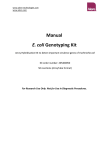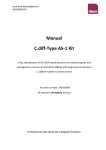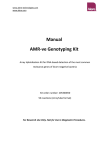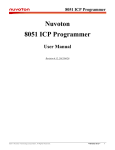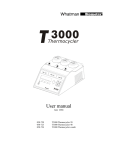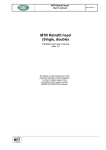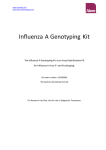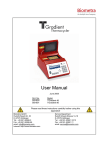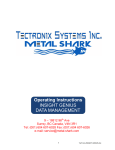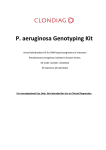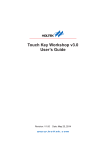Download E. coli Pathotyping Kit - Alere Technologies GmbH
Transcript
E. coli Pathotyping Kit Array Hybridisation Kit for DNA-based detection of genetic pathogenicity markers of Escherichia coli. For Investigational Use Only. Not Intended for Use in Clinical Diagnostics. www.identibac.com #05_16_04_0006_V05 Content BACKGROUND ............................................................................................................................................................... 3 GENERAL INSTRUCTIONS FOR USE ................................................................................................................................ 4 KIT COMPONENTS, STORAGE AND STABILITY ............................................................................................................... 6 SOFTWARE AND READER .............................................................................................................................................. 8 PROTOCOL..................................................................................................................................................................... 9 1. E. coli DNA........................................................................................................................................................... 10 2. Worklist............................................................................................................................................................... 11 3. Linear amplification and biotin labelling ........................................................................................................... 12 4. Hybridisation ...................................................................................................................................................... 13 5. Prepare reagents for detection and staining ..................................................................................................... 15 6. Setup of the ArrayMate Reader ......................................................................................................................... 15 7. Washing after Hybridisation .............................................................................................................................. 17 8. Addition of HRP conjugate and staining ............................................................................................................ 17 9. Data Acquisition in the ArrayMate Reader........................................................................................................ 19 FORMAT OF THE RESULTS (ArrayMate) ...................................................................................................................... 22 FORMAT OF THE RESULTS (ATR03) ............................................................................................................................. 23 TROUBLESHOOTING .................................................................................................................................................... 24 LITERATURE ................................................................................................................................................................. 25 ADDITIONAL INFORMATION ....................................................................................................................................... 25 Warranty ................................................................................................................................................................. 25 Quality Control ....................................................................................................................................................... 25 List of components for separate order .................................................................................................................. 26 LEGAL MANUFACTURER .............................................................................................................................................. 26 CONTACT ..................................................................................................................................................................... 26 www.identibac.com 05_16_04_0006_V05 2 BACKGROUND The IDENTIBAC E. coli Pathotyping Kit is a quick and simple method for pathotyping Escherichia coli. Virulence genes present in E. coli clinical isolates of both human and animal origin can be determined using the ArrayTubeTM system. For Investigational Use Only. Not Intended for Use in Clinical Diagnostics. TEST PRINCIPLE. DNA isolated from bacterial clones is amplified approximately 40-fold and labelled with biotin-dUTP adopting a so called linear PCR protocol. In linear PCR only one primer is used instead of a primer pair, producing single stranded reaction products only, therefore limiting the degree of amplification (limited risk of cross-contamination). Labelled single stranded DNA is transferred and hybridised to microarrays with 124 probes representing different genetic markers plus a staining control plus a negative control (single redundant each). Spot recognition as well as geometric layout is performed automatically based on scans of the arrays and advanced image processing. The target set consists of a variety of genetic pathogenicity markers of Escherichia coli. THE RESULTING typing data provide information regarding genetic predisposition for pathogenicity of the analysed Escherichia coli bacterial isolates, respectively. THE ASSAY IS DESIGNED to be performed by personnel trained in microbiological and molecular biological laboratory methods. www.identibac.com 05_16_04_0006_V05 3 GENERAL INSTRUCTIONS FOR USE Intended Use For Investigational Use Only. Not Intended for Use in Clinical Diagnostics. The kit is manufactured for research use only. The kit is intended for use by personnel that are well-trained in molecular biology. Preparation of DNA from E. coli colonies (clones) requires expertise in microbiology and the local regulations for handling of potentially infectious organisms are to be obeyed. Specifications Upon receipt the assay components need to be stored at different temperatures as specified on the package insert. The assay is to be performed at an ambient temperature of 18°C to 28°C unless otherwise specified. Technical Support If you require any further information on this product please contact: Alere GmbH Am Wassermann 28 D-50829 Köln Fon: +49 - 221 - 271 43 - 392, - 391 Fax: +49 - 221 - 271 43 - 491 e.mail: [email protected] or visit our website: www.identibac.com Safety Precautions DNA preparation must be performed under the biosafety conditions as defined by your local authorities for work with E. coli strains that are suspected to be pathogenic. In most countries, Biosafety Level 2 is obligatory for this kind of work. E. coli DNA may be processed in laboratories below this biosafety level, if potential contamination by living E. coli bacteria can be definitively eliminated. Always wear protective clothes as regulated for laboratory work by your local authorities. www.identibac.com 05_16_04_0006_V05 4 Material Safety Data Sheets (MSDS) Per OSHA 29CFR1910.1200, Commonwealth of Australia [NOHSC:1005, 1008(1999)] and the latest amendments to the European Union Directives 67/548/EC and 1999/45/EC, the enclosed reagents do not require a Material Safety Data Sheet (MSDS). They do not contain more than 1% of a component classified as hazardous and do not contain more than 0.1% of a component classified as carcinogenic. MSDS therefore are not provided. Nevertheless, the buffers may cause irritation if they come into contact with eyes or skin, and may cause harm if swallowed. The regular precautions associated with laboratory work should be obeyed (e.g.: wear protective goggles, gloves and lab coat and avoid contact with the reagents). In case buffers or solutions are spilled, clean with laboratory detergent and water. Alere assumes no liability for damage resulting from handling or contact with these products. If you have any questions please contact our Technical Support (see above). Shipping Precautions RID/ADR: Kein Gefahrgut/ No dangerous goods IMDG: No dangerous goods IATA: No dangerous goods www.identibac.com 05_16_04_0006_V05 5 KIT COMPONENTS, STORAGE AND STABILITY Please keep in mind the limited surplus of each reagent when pipetting. Arrays and B1EC, respectively, are by far the most expensive and hence the limiting components of the kit. All components may be ordered separately; please refer to the order numbers at the end of this manual. For pricing please contact your local representative or our customer service, respectively. DNA labelling and amplification • B1EC: Labelling Buffer. Store at 2-8°C. Surplus: 40%. • B2: Labelling Enzyme. Store at 2-8°C. Surplus: 200%. Hybridisation and Detection • ArrayTubes (10 x 5 samples), protected against light and sealed under inert gas. Store at 18°C to 28°C. After opening to be used within two weeks. Close the unused tubes, protect them against humidity and dust and store them at a dark place. Avoid ANY touching or scratching the microarray on the bottom of the well. CAUTION: Do not store or handle unused wells above 60% relative humidity since this may irreversibly corrode the spots. • C1: Hybridisation Buffer. Store at 18-28 °C, protect against sunlight. Surplus: 100%. • C2: Washing Buffer 1. Store at 18 °C - 28 °C, protect against direct sunlight. Surplus: 60%. • C3: HRP Conjugate 100x. Store at 2-8 °C, protect against direct sunlight. Surplus: 300%. • C4: Conjugate Buffer. Store at 18°C to 28°C, protect against direct sunlight. Surplus: 500% • C5: Washing Buffer 2. Store at 18°C to 28°C, protect against direct sunlight. Surplus: 140%. • D1: Horseradish Peroxidase Substrate. Store at 2-8°C, protect against direct sunlight. Surplus: 200%. Expiry date is to be found on each bottle and on the outer package All components have been tested for stability for short term shipment (<1 week) at ambient temperature (< 37 °C). The kit components with limiting stability are D1 and C3, respectively. www.identibac.com 05_16_04_0006_V05 6 The other components have proven to be stable even six months after the kit expiry date has passed. Components required but not provided • DNA preparation kit. The assay has been tested with the DNeasy Blood & Tissue Kit from Qiagen, cat# 69504 according to Qiagen’s instructions for DNA preparation of gramnegative bacteria. • RNAse (we recommend Qiagen’s RNase A solution, 100 mg/mL, Qiagen order number: 19101). Instrumentation provided by Alere (to be ordered separately) • ArrayMate Reader (or ATR03 reader, respectively) Materials and instruments required but not provided by Alere • Equipment, growth media and consumables needed for the cultivation of E. coli • Equipment needed for DNA isolation, e.g. pipettes, centrifuge, thermoshaker or robot • Photometer for quality control of DNA. • Equipment for DNA gel electrophoresis for quality control of DNA. • Thermocyler • Thermoshaker: we strongly recommend the BioShake iQ from Quantifoil Instruments (http://www.qinstruments.com/) equipped with a specialised platform for the warming of Alere’s ArrayTubes. Alternatively, you may use Eppendorf’s Thermomixer Comfort, equipped with a platform for the warming of reaction tubes. • Pipettes: suitable for 1µL-5µL volumes, 90µL, 100µL, 200µL, 1000µL • For removal of liquid from the ArrayTubes we recommend the use of plastic Pasteur pipettes with flexible tips. • Reagent tubes suitable for PCR • Ultrapure water www.identibac.com 05_16_04_0006_V05 7 SOFTWARE AND READER Please keep in mind that you need to install a kit specific software on your reader! Image analysis for any IDENTIBAC test kit and on any IDENTIBAC reader is performed by the iconoclust software that has been delivered along with the reader. In addition, some test kit specific information tied to some reader specific information needs to be installed separately. This information (like spot names, marker names, location of the spots on the array, size of the image taken by the reader’s specific camera) is provided by the specific iconoclust package. Whenever you want to work with a kit OR a kit version you have never worked before, please install the appropriate iconoclust package first! The appropriate package you may download from our website www.identibac.com and install it on your reader according to the instructions you will find on this website. Please note: You should NOT use a “package” for ArrayMate that has been designed for ATR03 and vice versa. The ArrayMate Reader by default has all software on board except the E. coli Pathotyping kit specific package 50202.icpck that may be missing ant that you may need to install as outlined above. Unlike ATR03, ArrayMate is not linked to problems with compatibility of software. The ATR03 reader is a research tool that is highly versatile but it requires several pieces of software to be installed on an external PC (please refer to the latest version of the ATR03 manual for details). The E. coli Pathotyping kit specific package 050202.icpck is not compatible with iconoclust versions older than version 3.1. Whilst the E. coli Pathotyping test runs both on the ArrayMate Reader and on the ATR03 reader, respectively, this manual describes the reading of processed AT on the ArrayMate reader only. If you want to use ATR03, please refer to the latest version of the ATR03 manual or contact your local distributor or Alere’s technical service, respectively. www.identibac.com 05_16_04_0006_V05 8 PROTOCOL The graphic on this page summarises the test procedure but due to limited space it is missing important details. Therefore it is crucial to refer to the text section of this manual at any step of the test protocol. prepare DNA processing time handsontime grow bacteria (not part of the kit) over night 5 min isolate DNA (not part of the kit) 3-4 h 10-40 min 2h 5 min 10 min 10 min 2 min 2 min hybridise (55 °C, 550 rpm; 60 min ) 60 min 0 min discard DNA, add and remove 0,5 ml Buffer C2, incubate twice in 0.5 ml Buffer C2; 30 °C, 550 rpm, 5 min 15 min 15 min incubate in 0.1mL C3 : C4 (1 : 100), 30 °C, 550 rpm, 10 min 10 min 2 min discard conjugate incubate twice in 0.5 ml Buffer C5, 30 °C, 550 rpm, 1 min 5 min 5 min incubate with substrate (0.1 ml Buffer D1, RT, 10 min) 10 min 10 min take image WITHOUT removing D1, analyse 15 min 15 min prepare Arrays • rinse arrays (0.5 ml water , 55 °C, 550 rpm, 2min) • incubate in buffer C1 (0.5 ml, 55 °C, 550 rpm, 4 min • discard C1, process promptly label DNA in Thermocycler: 5 µl DNA + 4.9 µL B1EC + 0.1 µL B2 to 10 µL of labelling product add 90 µL of Buffer C1 transfer DNA to ArrayTube total time requirement : over night + 7-8 h www.identibac.com 05_16_04_0006_V05 80-110 min 9 1. E. coli DNA The required specimen for the E. coli Genotyping test is 0.5-2 µg of intact DNA from a single clone of E. coli. The DNA specimen needs to be virtually free of RNA as determined by agarose gel electrophoresis. Please note: This assay requires much more DNA than common PCR applications. Most performance problems with the E. coli Genotyping Kit are due to insufficient amounts of DNA. We therefore strongly recommend to follow the protocol outlined below. From several DNA isolation methods tested so far, only the DNA extraction Kits from Qiagen yielded sufficient DNA. CAUTION: E. coli strains bearing genetic information of special virulence factors are potentially pathogenic. All procedures prior to complete death of the bacteria need to be performed by properly trained staff in a biosafety Level 2 facility. Harvest of bacteria From a bacterial clone grow enough cells to fill an inoculating loop (diameter: 1 mm) as pictured below. • Add an inoculating loop of bacteria to 0.18 mL to reagent ATL (Qiagen kit). loop empty loop full It is important to harvest enough bacteria; this is a prerequisite for extraction of sufficient DNA. Take an inoculating loop of 1mm diameter filled with bacteria as shown in the left picture. Extraction of DNA • Proceed with the DNA preparation protocol of the DNA preparation kit. For the Qiagen DNeasy Blood&Tissue Kit: • Add 20 µL proteinase K (Qiagen Kit) • Add 200 µL buffer AL (Qiagen Kit) • Vortex shortly or shake vigorously www.identibac.com 05_16_04_0006_V05 10 • Incubate for 30-60 min at 56°C and 550 rpm in the thermoshaker • important: add 4 μl RNase A (100 mg/ml), mix by vortexing, and incubate for 2 min at room temperature before continuing • From the Qiagen kit manual follow Qiagen protocol “Purification of Total DNA from Animal Tissues” (next step: add 200 µL of Ethanol). IMPORTANT BEFORE CONTINUING: • Check for DNA integrity and absence of RNA (agarose gel). In case, remove RNA using RNAse. Measure DNA concentration (A260 method). 2. Worklist For the regular “USER” mode of the ArrayMate it is obligatory to up-load a worklist onto the Reader before an analysis can be performed. For future data mining we recommend the use of a worklist also for the ”R&D” mode. The worklist may be exported from a LIMS or designed in EXCEL or any other appropriate software. The final format must be a wordpad (*.txt)-format that can be imported into the test specific ArrayMate software (see below). For setting up a worklist: • Create a list with at least three columns. • The columns must have headers written into the first line. • Each header MUST be one word (different words may be linked by “_”). • Don’t use special characters like : ; ( / \ etc. • The following headers are obligatory (in this order): position sampleID assayID where: - position = position 1 to 6 of the metal frame to be used for reading in the ArrayMate. List position numbers of wells that are to be analysed in a continuous fashion; DO NOT leave empty lines in the worklist; If you use EXCEL: You need to type the position numbers into column A (Note: the raw numbers of the EXCEL spread template sheet CAN NOT be used to indicate well position). - sampleID = your sample ID as exported from your LIMS (or assigned in any different way) - assayID = 50202 (ID number of the E. coli Genotyping assay). DO NOT use a different assay ID since this could lead to loss of data. www.identibac.com 05_16_04_0006_V05 11 • You may add further columns and headers at your convenience. • Example: position sampleID assayID comment 1 2 3 4 5 6 12345 12346 12347 12348 12349 12350 50202 50202 50202 50202 50202 50202 Dr. Jones Dr. Miller Dr. Yale Dr. Palmer Dr. Jones Dr. Jones • We recommend using a printout of the worklist as guidance for pipetting. • Always convert your file into a wordpad (.txt) format (tabstop-delimited version!) • Safe the wordpad (*.txt) file of the worklist onto the memory stick provided along with the ArrayMate. • To avoid confusion make sure that earlier versions of the worklist have been deleted from the memory stick. 3. Linear amplification and biotin labelling Please keep in mind the limited surplus of reagents whilst pipetting. The surplus of B1EC is 40% . • Suspend 0.5-1.5 microgram of clonal and intact E. coli DNA in 5 µL of ultrapure water in a reagent tube suitable for PCR (concentrate DNA if necessary by evaporation in a vacuum centrifuge or by precipitation). Do not forget to label the vial! • Prepare a Master Mix by combining 4.9 µL of B1EC (2x Labelling Buffer) and 0.1 µL of B2 (DNA Polymerase) per specimen. • Add suspended DNA to a 5 µL aliquot of the MasterMix • Perform the following thermocycler protocol (required time: approximately 2 hours) Pre-heat cover/lid to 105°C 300 sec at 96°C 20 sec at 50°C 45 cycles with 30 sec at 72°C 20 sec at 96°C Cool down to 4°C, hold www.identibac.com 05_16_04_0006_V05 12 4. Hybridisation General Precautions • For removal of liquid from the ArrayTubes we recommend the use of plastic Pasteur pipettes with flexible tips. • Never touch the Array surface. Remove liquid with a pipette: always place the pipette tip at the cavity between the array and the wall of the tube. If you touch the array surface, probes may be scratched off and this may cause an error. • Avoid any complete drying of the array surface during processing (i.e. do not allow it to stay without liquid for more than two minutes) • We strongly recommend that the liquid is removed by pipettes instead of inverting the tubes and flicking them out. • Please keep in mind the limited surplus of C1 (100%). www.identibac.com 05_16_04_0006_V05 13 • Always label your ArrayTubes with a laboratory marker at the recommended position. Never label them on the bottom or across the data matrix barcode. This may cause an error. • Avoid contact of data matrix barcode with organic solvents • Avoid touching the bottom of the ArrayTube and keep it clean • Never rinse the tubes with water after hybridisation • Always cap the tubes before incubation in the thermoshaker Preparation of the hybridisation mixture • Pre-heat the thermoshaker to 55 °C • Add 90 µL of buffer C1 to each labelling product, mix gently (vigorous mixing results in foaming) and put aside. Pre-washing of the arrays (2 washing steps) • Remove the ArrayTube from the bag (open the bag at its predetermined breaking point) • Add 500 µL of ultrapure water to each tube • Incubate in the thermoshaker at 55 °C, 550 rpm for 2 minutes • Remove and discard the water WITHOUT TOUCHING THE ARRAY SURFACE • Add 500 µL buffer C1 to each tube • Incubate in the thermoshaker at 55 °C, 550 rpm for 4 minutes • Remove and discard buffer C1 • Proceed promptly (hybridisation mixtures must be ready when buffer C1 is removed) Hybridisation • Transfer each hybridisation mixture (100 µL) to a prepared ArrayTube (avoid extensive foaming) www.identibac.com 05_16_04_0006_V05 14 • Incubate for one hour at 55°C and 550 rpm on a thermoshaker 5. Prepare reagents for detection and staining Dilute Streptavidin-Horseradish-Peroxidase (C3, C4) • Combine Reagent C3 (Streptavidin-Horseradish-Peroxidase) : Buffer C4 = 1 : 100 => C3/C4 The mixture is stable for 1 day at room temperature; C3 is delivered with a surplus of 300%, C4 is delivered with a surplus of 500%. • • Pipetting scheme: C3 1 well 1.5 µL 2-3 wells 3.5 µL 4-6 wells 7 µL 7-10 wells 11 µL 11-15 wells 16 µL 16-20 wells 21 µL 21-30 wells 32 µL 31-40 wells 42 µL C4 150 µL 350 µL 700 µL 1100 µL 1600 µL 2100 µL 3200 µL 4200 µL put aside at room temperature until use Pre-warm the staining reagent D1 • Transfer enough reagent D1 into a separate vessel (e.g. a clean and sterile centrifuge tube), 100 µL for each well and a surplus of not more than 20% • put aside at 20 to 25°C until use. Please note: cold D1 may yield in weak signals. Centrifuge D1 immediately prior to staining (see below), otherwise clots within D1 may contaminate your array. 6. Setup of the ArrayMate Reader We recommend to set up the ArrayMate Reader after having started the hybridisation; this allows you a restart without time pressure in case of any software problems. This is a short instruction only. For more detailed information please refer to the ArrayMate User Manual. • Switch on the ArrayMate (main switch on the rear below the electric cable plug, operating switch on the bottom/left corner of the front side). • Switch on the screen (switch right hand below the screen). www.identibac.com 05_16_04_0006_V05 15 • Login as “User R&D” (password to be defined by the instrument’s administrator on the customer’s site and to be initially implemented by the supplier’s technical service). (The user interface is loaded, ArrayMate performs internal testing for < 1 minute) • Click on the icon “New Run” (left upper edge of the screen; a suggestion for a run name for the new run appears in the top line of the screen). • You may now modify or change the experiment name at your convenience. • Type in your operator ID. • If desired, you may enter a comment into the “memo” field. • Insert your memory stick containing the worklist (use any of the USB ports down to the right side of the ArrayMate). • Press the button: • Select your worklist (path: “My Computer/Removable Disk”) (a folder selection dialog opens) Caution: Make sure to chose the correct worklist! Caution: By default an example file for a worklist is selected. This file is only for training purposes! Do NOT use it for your experiments! • Open your selected worklist with “Enter” or the button “Open” • Press the button: (your imported worklist opens in a separate window). Check for correctness. If the new window is empty or the worklist is not the desired one, repeat the import. • Press the button “ok” (worklist-window is closing). • Leave the memory stick attached to the ArrayMate if you intend to export test data afterwards. www.identibac.com 05_16_04_0006_V05 16 7. Washing after Hybridisation Washing after hybridisation (3 washing steps) • Please keep in mind the limited surplus of C2 (60%) • Remove the ArrayTubes from the thermoshaker • Set the thermoshaker to 30°C for the following steps (cooling will take some minutes) • Carefully open the tubes and remove the hybridisation mixture as completely as possible (without touching the array surface) • 1st Washing step after hybridisation: add 500 µL of buffer C2 remove and discard the washing solution WITHOUT TOUCHING THE ARRAY SURFACE • 2nd Washing step after hybridisation: add 500 µL of buffer C2 incubate in the thermoshaker for 5 min at 30 °C, 550 rpm remove and discard the washing solution • 3rd Washing step after hybridisation: repeat 2nd Washing step NOTE: a carryover of more than 1% of buffer C1 to the next step will denature the HRP 8. Addition of HRP conjugate and staining Addition of HRP-conjugate NOTE: - the used wells do not need to be capped any more - Reagent C3 contains Streptavidin-Horseradish Peroxidase (HRP) that would denature and lose its activity at 55°C. Do NEVER incubate above 30°C. Make sure that the thermoshaker has cooled down before mounting the ArrayTubes! • • Please keep in mind the limited surplus of C3 (300%). Combine Reagent C3 (HRP) : Buffer C4 = 1 : 100 => C3/C4 (see section 5) - the mixture is stable for 1 day at room temperature - both reagents are delivered with a surplus of more than 100% each Add 100µL of C3/C4 to each tube www.identibac.com 05_16_04_0006_V05 17 • Incubate for 10 minutes at 30°C and 550 rpm on a thermoshaker • Remove and discard C3/C4 completely Washing step after binding of conjugate Addition of HRP-conjugate (2x) • Please keep in mind the limited surplus of C5 (140%) • add 500 µL of buffer C5 Shake for 1 minute at 30°C and 550 rpm on a thermoshaker remove and discard the washing solution • Repeat this step once. NOTE: a carryover of more than 0.5% of C3/C4 into the following staining reagent will create black particles which in the worst case may mimic signals (hybridised spots). On the same time, real signals may appear pale due to competition of soluble Horseradish Peroxidase with the DNA-bound enzyme for substrate molecules. Staining of bound HRP-conjugate NOTE: - a carryover of more than 0.5% of C3/C4 will cause unwanted effects (see above) - do not move ArrayTubes during staining - Reagent D1 contains a substrate for Horseradish Peroxidase - Please keep in mind the limited surplus of D1 (200%). • D1 needs to be pre-warmed and centrifuged, see section 5 • Add 100µL of reagent D1 to each well (supernatant of centrifuged D1 without precipitate) • Incubate at room temperature WITHOUT agitation for 10 min • Read out without removing D1 (removal of D1 would leave air bubbles within the tubes) CAUTION: the strips MUST be clean underneath the arrays and there MUST NOT be air bubbles or remains of liquid in the wells. Strips may be cleaned with lint-free wipes, bubbles may be removed by adding and removing D1 again. PLEASE NOTE: The ArrayTubes as used in this kit do have a different geometry than the 8-well ArrayStrips that are used in other kits. Therefore, unlike the directive for ArrayStrips, D1 is NOT to be removed from the ArrayTubes before reading. www.identibac.com 05_16_04_0006_V05 18 9. Data Acquisition in the ArrayMate Reader The reading process The setup of the reader is briefly described in the section 6 “Setup of the ArrayMate Reader”. • Press the button “next” (bottom/right on the screen; reader is opening). • Carefully insert the appropriate metallic adapter for ArrayTubes into the ArrayMate. Do not apply any strong force. • After having inserted the adapter, carefully insert the Array Tubes into the adapter. • ArrayTubes need to be open with tube-lid connections placed into appropriate notches: • Assure proper fit, otherwise the images may be out of focus. • CAUTION: the strips MUST be clean and free from air bubbles and liquid! • Barcodes on ArrayTubes and holder must be clean. • Press the button “Next” (bottom/right on the screen; reader is closing, analysis program starts, it takes ca. 2-5 min dependent on the number of ArrayTubes; reader takes images AND automatically analyses the data). The progress of the reading is indicated by the following symbols: photographed: in analysis: ready: The reader indicates the end of the entire process with an acoustic signal (beep). • Press the button “Next” (bottom/right on the screen; reader is opening) • Remove the ArrayTube(s). • Press the button “Next” (bottom/right on the screen; reader is closing). www.identibac.com 05_16_04_0006_V05 19 Results • On the left hand of the screen you will see a list showing all readings stored on the ArrayMate. A reading contains the results from all arrays analysed together in one frame. If this list is not visible: - press the button “Archive” (left hand) - activate the Flag “Browse” (top left). • The readings are organised like folders in “Windows”. Example: there are several readings in the archive, by default they are named by date and time of day of creation (which you may have changed, see section “setup of the ArrayMate reader”): • Click onto the plus symbol of one defined reading, the folder opens and you will see a list of the individual ArrayTube(s) (sorted by position within the adapter). • Activate the Flag “raw data” (top left) and click onto the position of an individual tube (e.g. 01-A), the results of this particular array will appear on the right side of the window: Note: the flags “results” and “results b” are not active with this assay. www.identibac.com 05_16_04_0006_V05 20 • Interpretation of the “raw data” list: - Spot ID: numerical identifier of the spot on the array - Substance: name of the DNA probe - Confidence: an intrinsic estimate of spot confidence based on size and shape of that particular spot, where 1 = high confidence and 0 = no confidence - Signal: spot signal intensity (grey scale value), where 1 = black and 0 = white - valid: 0 = valid; 1 = invalid (confidence below 0.75) - Background: luminous intensity of the background, where 1 = maximum brightness and 0 = maximum darkness - Mean: luminous intensity of the signal (spot), where 1 = maximum brightness and 0 = maximum darkness The correlation between mean, background and signal is roughly: 1-mean/background, however, there are some correction factors that depend on the statistics of pixel distribution. Export of E. coli Genotyping Test Results • Note: only complete readings can be exported. The export of Test results for individual ArrayTubes of a reading is not possible • Right-Click on the desired reading (a menu appears with the option “Export Run”) www.identibac.com 05_16_04_0006_V05 21 • Right-Click on “Export Run” (a file browser opens) • Click on “My Computer”, then on “Removable Disk” and choose an appropriate storage place • Click on the button “Make New Folder” (on the bottom; a new folder icon appears) • Rename the new folder(e.g. with the experiment name) • Click on the ”Ok” button (data are exported now into the new folder on your memory stick) • Do NOT remove the memory stick as long as the hourglass symbol is visible. Switch off the device Click on the “Power”-button (left/down on the screen): Switch off the Screen. There is no need to physically switch off the ArrayMate. In case of any hang-up: restart the computer by pressing the on/off button (bottom/left on the ArrayMate reader face). FORMAT OF THE RESULTS (ArrayMate) The ArrayMate creates a test report that lists all markers that have been analysed along with an individual test result for each marker. www.identibac.com 05_16_04_0006_V05 22 FORMAT OF THE RESULTS (ATR03) From October 2011 (after software update) also ATR03 will create a user-friendly test report. Up to then the result file that is exported from the ATR03 may be transformed into an Excelcompatible format like this: Spot ID 1 2 3 4 5 6 7 8 9 10 11 12 13 Substance K88ab_10 astA_consens_10 bfpA_10 cba_10 ccl_10 cdtB_40 cdtB_50 cdtB_60 celb_10 cfa_c_10 cma_20 cnf1_20 cofA_10 Confidence 1.000000 0.546296 1.000000 0.924457 0.900066 0.95421 0.95421 0.891279 0.731481 1.000000 1.000000 1.000000 0.856323 Signal 0.866366 0.051432 0.883014 -0.000794 0.003228 0.857459 0.572145 -0.000566 0.001272 0.001629 0.872491 -0.000422 0.004607 Valid 0 0 0 0 0 0 0 0 0 0 0 0 0 Background 0.849185 0.85848 0.862151 0.87347 0.878431 0.876036 0.886699 0.891359 0.897874 0.895425 0.890287 0.904902 0.909804 Mean 0.06769 0.811578 0.053476 0.874207 0.875419 0.078118 0.347803 0.891895 0.896661 0.893875 0.065173 0.905307 0.905352 141 142 145 146 147 0,1M NaPP Standard pH 9 Biotin-Marke_2,5µM K88ab_10 astA_consens_10 bfpA_10 0.941429 1.000000 1.000000 0.546296 1.000000 -0.00168 0.835682 0.846823 0.089045 0.86565 0 0 0 0 0 0.897958 0.887522 0.900338 0.903499 0.896416 0.89956 0.099673 0.090458 0.818039 0.072136 . . . . . . The meaning of the columns of the raw data list has been outlined above. Please note, that each substance is represented by two spots, e.g. substance K88ab_10 is represented by the spots #1 and #145, respectively. Spots #141 and #283, respectively contain substance “0,1M NaPP Standard pH 9” which is a negative control, i.e. “Signal” of these spots should be far below 0.1. Spots #142 and #284, respectively contain substance “Biotin-Marke_2,5µM” which is a positive control, i.e. “Signal” of these spots should be above 0.5. For the meaning of the other substances/spots please refer to our gene list. www.identibac.com 05_16_04_0006_V05 23 TROUBLESHOOTING Data Quality In case of poor data quality we recommend to re-check DNA quantity and quality first by loading leftover DNA on an agarose gel. • The amount of DNA is crucial. A260 readings will cover RNA and other contaminants as well. Therefore pure DNA preparation without bulk amounts of RNA are a prerequisite for proper DNA concentration measurement. RNAse treatment prior to A260 reading therefore is necessary (component A2 contains RNAse). • DNA must be unfragmented, as fragmentation reduces the efficiency of amplification and labelling due to the distance between primer and probe binding sites. • DNA should be free of RNA, as free RNA reduces the efficiency of amplification and labelling by effectively removing primer from the reaction mix due to competitive hybridisation. • DNA must be free of any traces of ethanol, as ethanol strongly influences the amplification. This is an important issue as, e.g., in the top of QIAGEN tubes a drop of ethanol-containing washing buffer might get trapped. The tubes really need to be centrifuged on high speed. Alternatively, it is possible to heat the sample prior to adding it to the labelling mix (some 5 minutes at 70°C). Some problems with samples from the Qiagen EZ1 device for example were resolved after heating the samples. • All reagents need to be within the recommended shelf-life and stored in the appropriate way. We have good experience with the manual QIAGEN DNeasy kit and the automated device EZ1. Contrarily, alkaline lysis, mechanical bead-beater extraction or ultrasonication in our hands resulted in poor DNA recovery, poor DNA quality or both. Control Spots In case that the signals of the negative control spots are above 0.1 AND the spot is set valid (column “valid”=0) please contact our customer service. In case that the signals of the positive control spots are below 0.5 proceed as follows: www.identibac.com 05_16_04_0006_V05 24 • Horseradish Peroxidase Conjugate may have degraded during storage. Add 1µL buffer C3/4 to 9 µL D1 (substrate). If the solution turns green within 3-5 seconds, the Horseradish Peroxidase still has sufficient enzymatic activity. • Enzymatic reaction is inhibited by carryover of buffer C1. Ensure proper washing of the wells to remove all of Buffer C1 prior to adding Horseradish Peroxidase Conjugate. Physical damage of the array Scratching of the array surface with a pipette tip can lead to the damage of array spots that prohibits the acquisition of a valid signal. In this case the respective spot is set invalid (=”1”) and the other spot is positive and valid (=”0”). We recommend to review section 4 for general precautions in array handling. LITERATURE Pathotyping Escherichia coli using miniaturised DNA-microarrays. Anjum MF, Mafura M, Slickers P, Ballmer K, Kuhnert P, Woodward MJ, Ehricht R.; Appl Environ Microbiol. 2007, Jul 13. ADDITIONAL INFORMATION Warranty Alere guarantees the performance as described in this manual. Usage of the Kit was successfully tested at ambient temperatures up to 37°C, a guarantee is limited to ambient temperatures in the laboratory between 18°C and 28°C. Kit components comprise the ArrayTubes, the reagents for DNA labelling and for detection of labelled DNA products on the array, the ArrayMate reader and its software. In case one of these components fails within the expiry date due to other reason than misuse, contact Alere for replacement or refund. Terms and conditions apply (www.identibac.com ). If you have any problem or question, please contact the technical service. Quality Control Each batch is stringently tested with the use of standard DNA preparations for good performance and correctness of results. www.identibac.com 05_16_04_0006_V05 25 List of components for separate order If required, these reagents for the E. coli Genotyping Kit may be ordered separately: component name category Labelling Buffer buffered reagents 360 µL B2 C1 C2 Labelling Enzyme Hybridisation Buffer Washing Buffer 1 buffered enzyme buffered reagents buffer 20 µL 30 mL 120 mL 245104000 245105000 245106000 C3 C4 C5 D1 HRP Conjugate 100x Conjugate Buffer Washing Buffer 2 HRP Substrate buffered enzyme buffered reagents buffer buffered reagents 200 30 120 15 245107000 245108000 245109000 245110000 ArrayTube E.c. Array E. coli B1 Ec amount µL mL mL mL St order no storage 2-8 °C 2-8 °C 18-28 °C 18-28 °C 2-8 °C 18-28 °C 18-28 °C 2-8 °C 18-28 °C For pricing please contact your local representative or our customer service, respectively. LEGAL MANUFACTURER Alere Technologies GmbH Loebstedter Str. 103-105 07749 Jena, Germany CONTACT If you require any further information on this product please contact: Alere GmbH Am Wassermann 28 D-50829 Köln Fon: +49 - 221 - 271 43 - 392, - 391 Fax: +49 - 221 - 271 43 - 491 e.mail: [email protected] or visit our website: www.identibac.com HU www.identibac.com UH 05_16_04_0006_V05 26



























